is you’re garden about to enter the winter months and you need to extend the season for your crops to produce? Are you lacking in budget for a good greenhouse? A hoop house is the answer you are looking for!
A hoop house is a small structure made of affordable components. It is flexible enough to fit nearly any garden bed. Below is our complete guide on how you can build one for your own garden!
Contents
Constructing a Hoop House
Materials
- 8′ long 2 x 6″ Untreated Fir
- Schedule 40 PVC Pipe
- 3/4″ diameter Railing
- 1/2″ diameter Hoops
- 1″ diameter Tees
- 1/2″ long, 1/2″ Aluminum Tubing pieces
- 9′ long, 1/2″ PVC Pipe
- High-quality Greenhouse Film
- 1/2″ Lath Screws with Washer Heads
- Clothespins / Clamps for Hoops
- 3/16″ Eye Screws
- 3/16″ Clothesline Cord
Tools
- Cordless Drill
- Hacksaw
- Staple Gun
- Measuring Tape
Instructions
Step 1: Prepare the Base
- Lay out the 8′ long 2 x 6″ untreated fir boards on the ground to form a rectangular base for your hoop house. This will serve as the foundation. Ensure the corners are squared.
Step 2: Install the Rails
- Cut the 3/4″ diameter railing to the length of your hoop house.
- Secure the railing to the long sides of the rectangular base using the cordless drill and lath screws. These rails will guide the hoops to glide open and close.
Step 3: Assemble the Hoops
- Use the hacksaw to cut the 9′ long 1/2″ PVC pipe into sections that will serve as your hoops. The number of hoops depends on the size of your hoop house and the desired spacing between each hoop.
- Insert the ends of each hoop into 1″ diameter tees placed at equal intervals along the railing. These tees will hold the hoops in place and allow them to slide.
Step 4: Connect the Hoops
- Cut smaller lengths of PVC pipe to connect the tops of the hoops, creating a ridge that reinforces the structure.
- Use the 1/2″ aluminum tubing pieces to join the hoops at their apexes, securing them with screws if necessary.
Step 5: Cover with Greenhouse Film
- Roll out the high-quality greenhouse film over the structure. Make sure it’s taut and covers the entire frame.
- Use the staple gun to attach the film to the base of the hoop house, ensuring that it’s secure and windproof.
- Trim any excess film using the hacksaw, leaving enough to secure the edges.
Step 6: Secure the Film
- Place clothespins or clamps along the hoops to keep the film in place temporarily.
- For a more permanent solution, screw the 1/2″ lath screws with washer heads through the film and into the wooden base.
Step 7: Install the Opening Mechanism
- Screw the 3/16″ eye screws into the frame at both ends.
- Thread the 3/16″ clothesline cord through the eye screws, attaching it to the base of the hoop house. This cord will be used to open and close the hoop house.
Step 8: Final Adjustments
- Make any necessary adjustments to ensure the hoops glide smoothly along the rails.
- Check the tightness of the greenhouse film and reinforce any areas as needed with additional screws or staples.
Hoop House Gallery
Click on any image to start lightbox display. Use your Esc key to close the lightbox.![]()
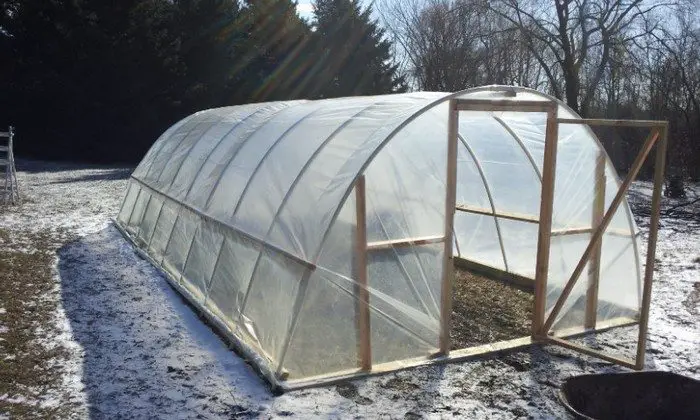
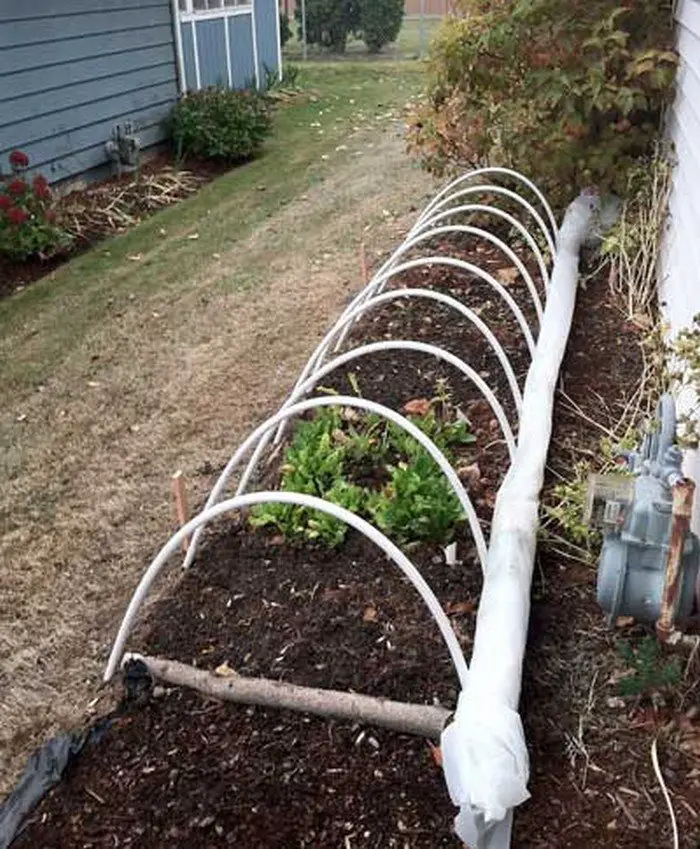
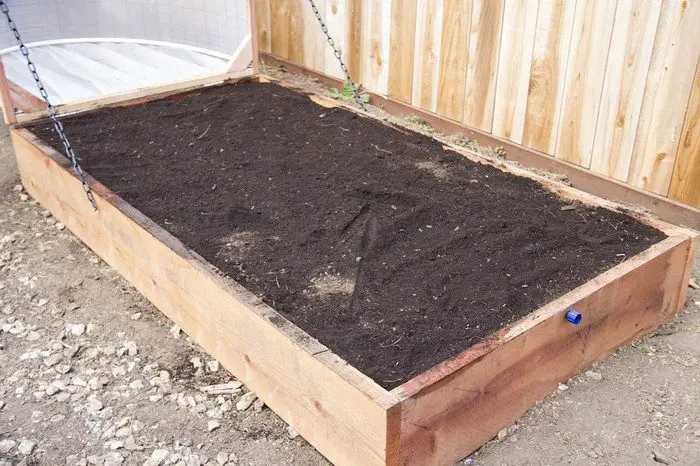
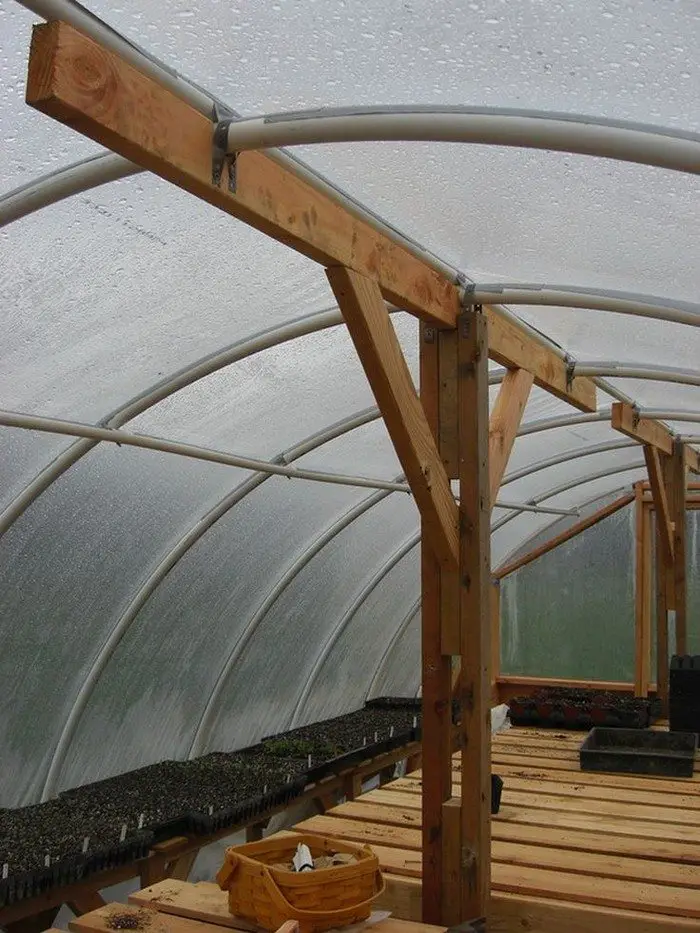
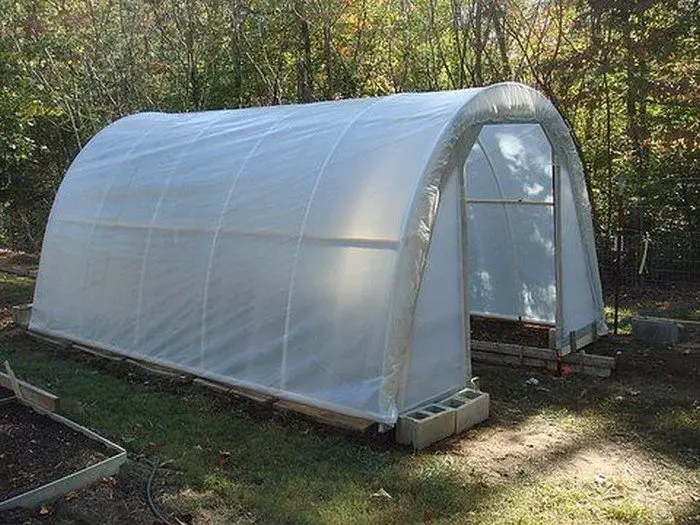
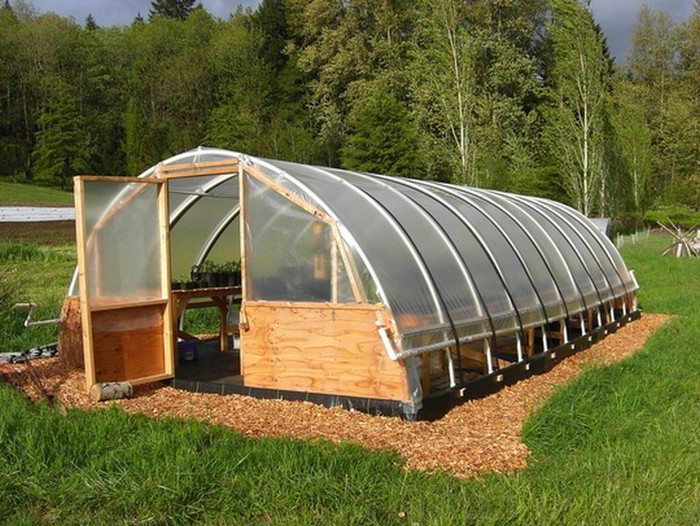
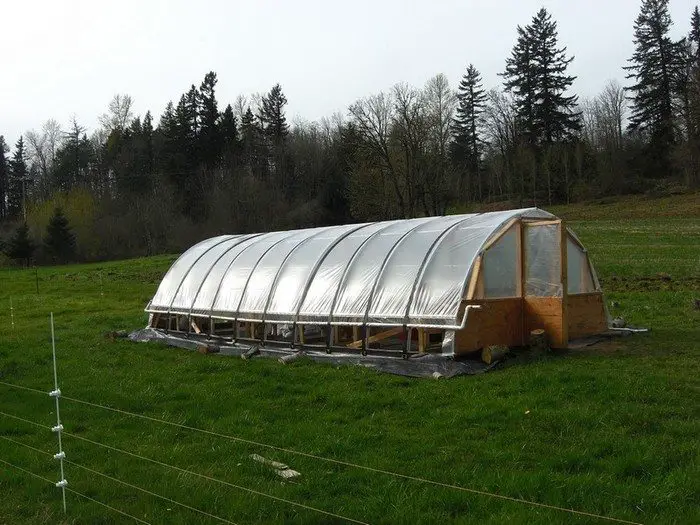

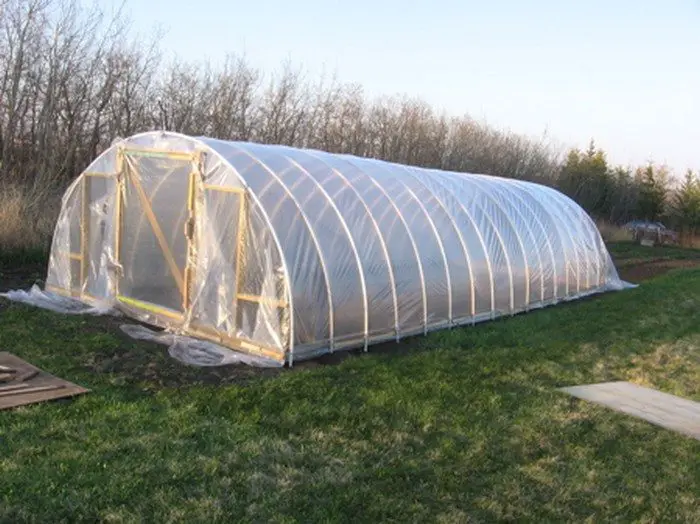
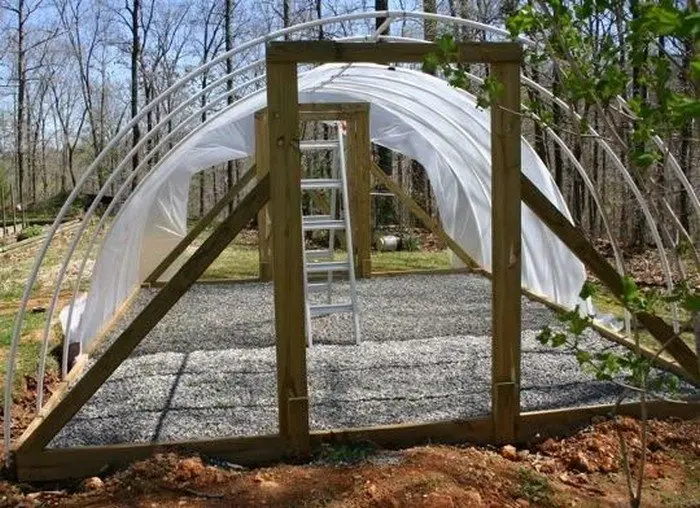
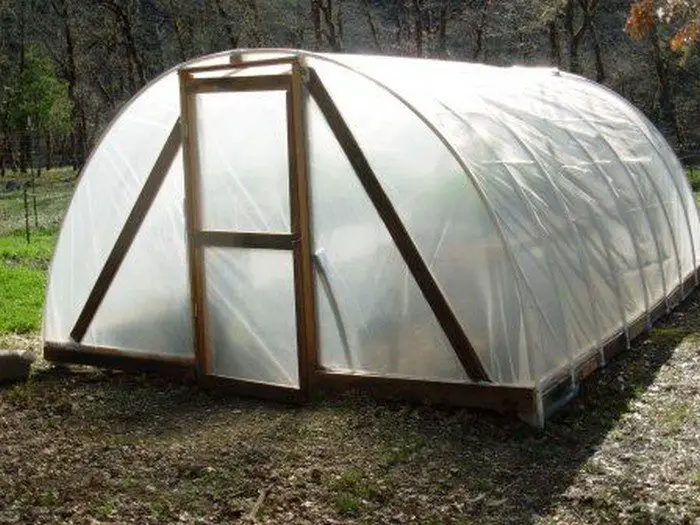
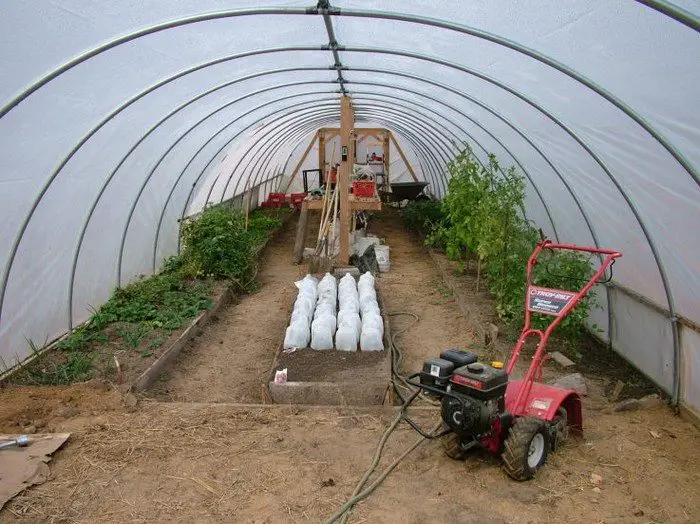
Combating Common Garden Pests and Diseases
Fostering a lush and vibrant garden within the confines of a hoop house offers a fantastic opportunity to extend your gardening season and shield your plants from the whims of the weather. However, if we’re not vigilant, this unique gardening environment can inadvertently roll out the welcome mat for pests and diseases. It’s critical to have strategies to navigate these challenges, ensuring your garden remains a bastion of health and productivity.
Ensuring Adequate Air Flow
Maintaining robust air circulation is a pivotal strategy in warding off diseases within your hoop house. Proper ventilation is crucial; it plays a significant role in balancing temperature and moisture levels, thereby creating less inviting conditions for fungi and other disease-causing organisms.
Consider installing vents or incorporating roll-up sides into your hoop house design. Opening these up during the day is routine, inviting a gentle breeze to sweep through and breathe life into your plants.
Keeping Humidity in Check
The battle against humidity is constant in the enclosed space of a hoop house. You’re going to bring in mold, mildew, and harmful funguses if your garden’s humidity is high. Arm yourself with a hygrometer to keep a watchful eye on the humidity levels inside your hoop house.
Should you find the moisture content tipping the scales, it’s time to take action. Boosting ventilation, opting for base-level watering techniques, and ensuring plants have ample space for air to flow freely around them are effective strategies to keep humidity at bay.
Embracing Integrated Pest Management (IPM)
Adopting Integrated Pest Management (IPM) within your hoop house is akin to crafting a masterful strategy that balances aggression with diplomacy in pest control. This approach doesn’t rely on a single method. Instead, it employs a harmonious blend of biological, cultural, physical, and chemical tactics designed to keep pest populations under control, all while minimizing any negative impacts on our health, wallet, and planet.
Tapping into biological controls can be particularly effective in the cozy confines of a hoop house. This involves either attracting or introducing natural predators into your garden ecosystem. Beneficial insects like ladybugs and lacewings can be formidable foes against common pests like aphids.
Meanwhile, predatory mites stand guard against spider mite invasions. This approach not only targets pests naturally and sustainably but also enriches the biodiversity of your garden, creating a more resilient and thriving environment.
Embrace Cleanliness as a Gardening Virtue
Keeping your hoop house tidy is more than just an aesthetic choice—it’s a defense mechanism against unwanted guests. Make it a routine to clear away plant leftovers and rogue weeds, as these can become prime real estate for pests and diseases looking for a home.
Before your tools and equipment cross the threshold into your hoop house, please clean them well. This simple act can be your first defense against sneaky pathogens aiming to take root in your garden. Additionally, don’t underestimate the power of crop rotation. This age-old practice keeps the soil healthy and less inviting to disease.
Opt for Disease-Resistant Varieties
When sketching plans for your hoop house garden, think like a chess player strategizing several moves ahead. Choosing plant varieties that naturally shrug off diseases can safeguard your garden from outbreaks that could otherwise take you by surprise. You’re forward-thinking approach not only spares you with potential headaches but also paves the way for a strong and resilient garden season after season.
Conduct Regular Garden Check-Ups
Think of yourself as the resident doctor for your hoop house garden, with regular check-ups on the agenda. Keeping a close eye on your plants can help you catch any signs of distress early on, allowing you to nip potential problems in the bud before they blossom into full-blown infestations.
Pay particular attention to the undersides of leaves and hidden nooks. These are the spots where where pests and diseases lurk.
Harness the Power of Biological Warfare
In the battle against pests, your allies don’t always come in bottles or sprays. Sometimes, they crawl, fly, or scuttle right into the heart of the fray. Encouraging or introducing beneficial insects, like the ever-hungry ladybug or the graceful lacewing, into your hoop house can turn the tide against pest populations.
These natural warriors can be incredibly effective in keeping your garden’s pest numbers in check, adding a layer of defense that’s gentle on the ecosystem and tough on intruders.

Innovative Ways to Automate Your Hoop House
You’re hoop house stands out as a beacon of innovation, extending growing seasons and safeguarding plants from the elements. Yet, the true potential of a hoop house unfolds when paired with automation. By integrating smart solutions, gardeners can streamline tasks, from watering to temperature control, transforming the hoop house into a near-self-sustaining ecosystem.
Let’s dive into some innovative ways to bring automation into your hoop house, enhancing efficiency and letting you focus more on the joys of gardening.
Automated Ventilation Systems
Automated ventilation systems can revolutionize the way you manage air flow and temperature in your hoop house. By installing sensors that monitor temperature and humidity, your ventilation can adjust automatically, opening to cool the interior on hot days and sealing up when the chill sets in. This not only ensures optimal growing conditions but also saves you the hassle of manual adjustments.
Self-Watering Systems
Imagine a hoop house where plants receive just the right amount of water at just the right time. Drip irrigation systems, governed by moisture sensors, can deliver water directly to the root zones of your plants, minimizing waste and ensuring your plants stay hydrated without the risk of overwatering. Pair this with a timer, and your watering schedule can run like clockwork, even when you’re away.
Temperature-Controlled Environment
Maintaining the ideal temperature is crucial for plant health and yield. Integrating a smart thermostat connected to heaters or coolers can help regulate the temperature inside your hoop house. These systems can be programmed to maintain specific temperature ranges, ensuring your plants grow in an environment that’s just right, regardless of the weather outside.
Automated Pest Control
Pest control can be one of the more time-consuming aspects of gardening. However, with ultrasonic pest repellers or automated insect traps, you can protect your hoop house garden from pests with minimal effort. These devices can be set up to operate automatically, deterring or capturing pests without constant supervision.
Solar-Powered Solutions
Consider powering your automated systems with solar energy for an eco-friendly automation twist. Solar panels can supply clean energy to run your watering systems, ventilation, and even pest control devices. This not only reduces your carbon footprint but also cuts down on energy costs, making your hoop house garden a beacon of sustainability.
By incorporating these innovative automation techniques into your hoop house, you’re not just simplifying your gardening tasks; you’re setting the stage for a more productive, efficient, and sustainable garden. Automation unlocks the full potential of your hoop house, letting technology take care of the routine while you revel in the rewards of a flourishing garden.
Conclusion
Building a hoop house for your garden is a transformative step towards achieving a more productive, resilient, and controlled gardening environment. It extends the growing season, offers protection against unpredictable weather, and creates an ideal space for a wide variety of plants to thrive. Embracing this garden project not only elevates your gardening experience but also brings you closer to the dream of year-round cultivation, making every effort well worth it.






